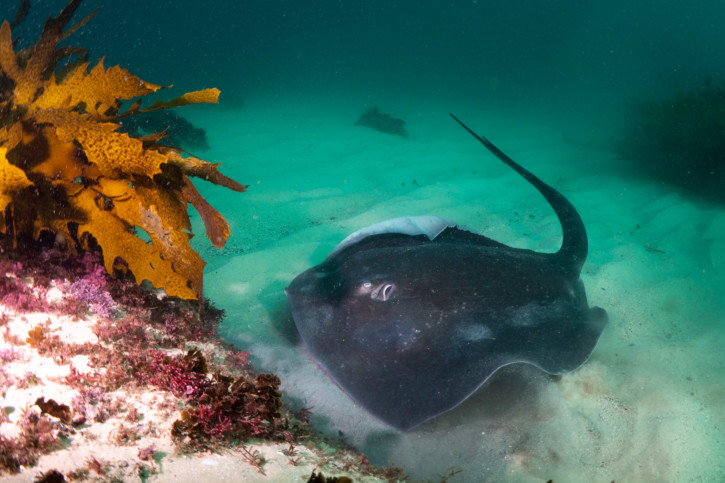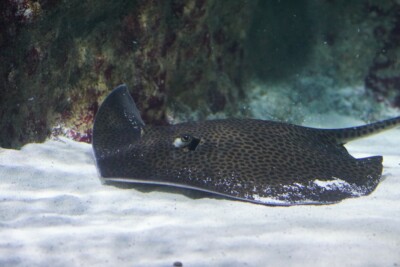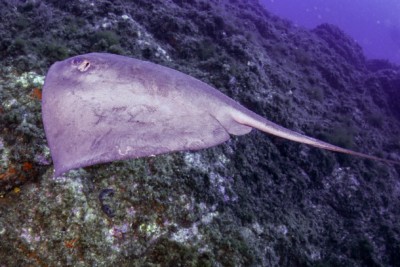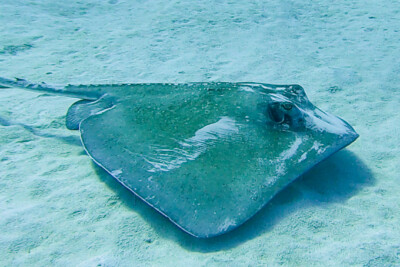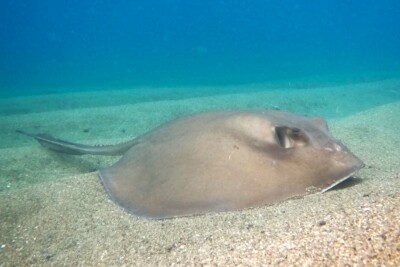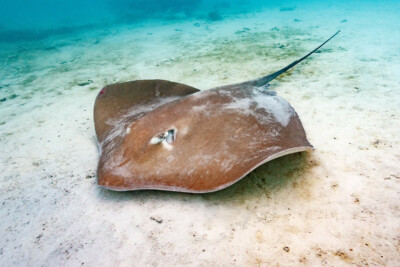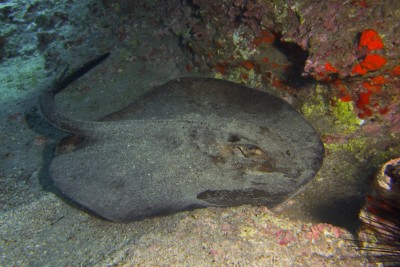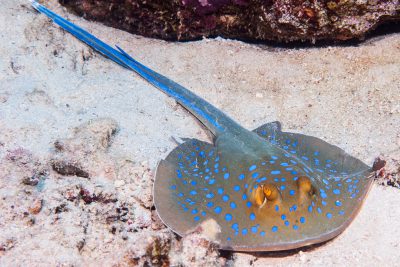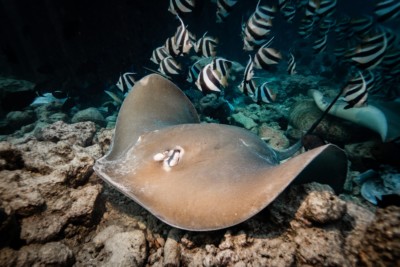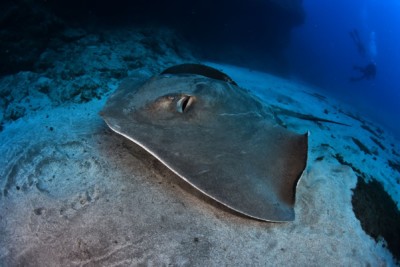smooth stingray
| Family | Dasyatidae |
|---|---|
| Genus | Bathytoshia |
| IUCN category (World) | LC |
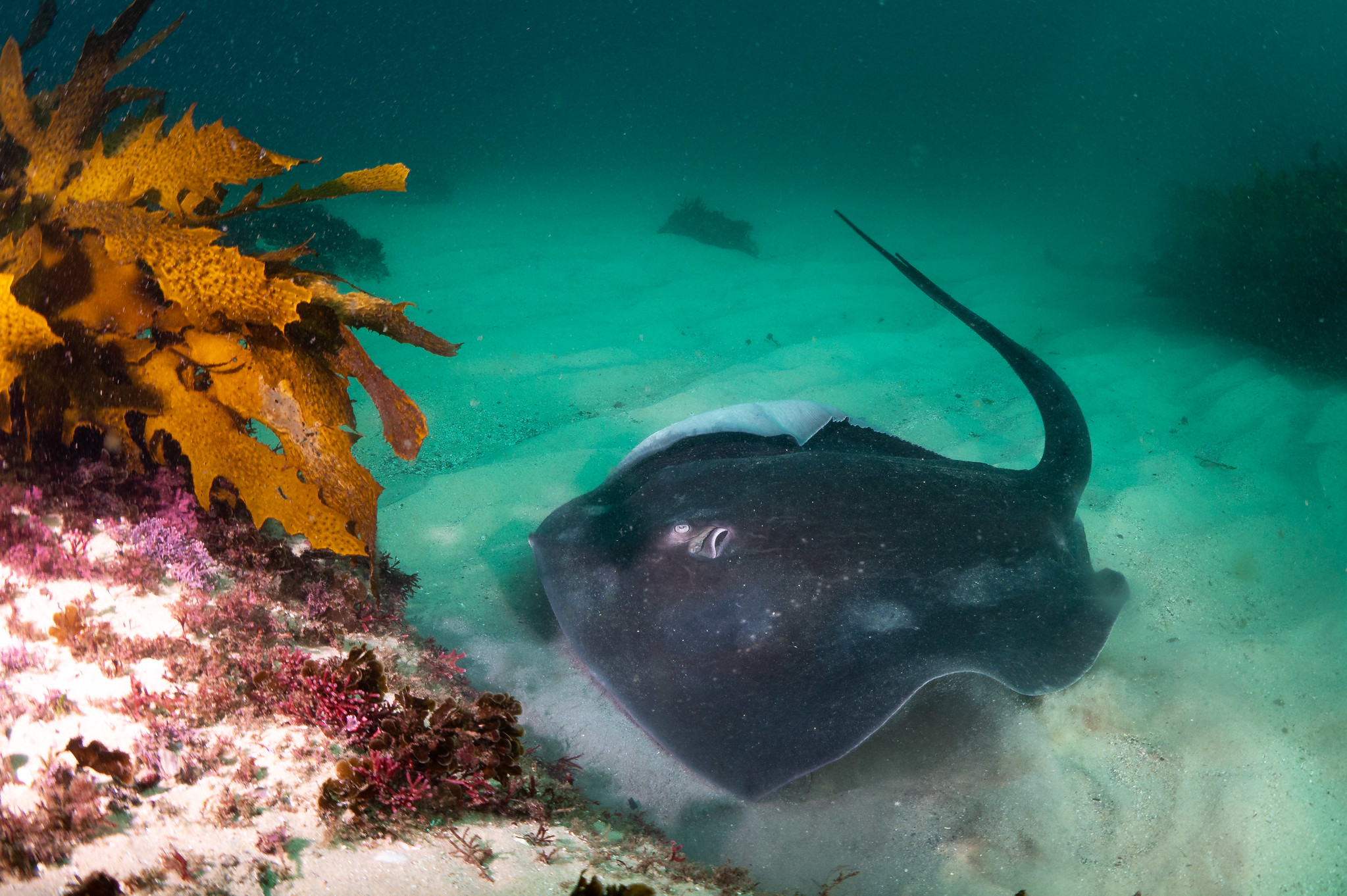

Introduction
The smooth stingray is the largest of all stingrays, with the largest individuals reaching 3.4 meters in length and 350 kg in weight.
This species is found in temperate waters from South Africa, southern Australia to New Zealand.
Who is it?
Morphology
-
Type
-
Average size125 cm
-
Maximum size430 cm
-
ShapeCircular
-
Type
-
Average size125 cm
-
Maximum size430 cm
-
ShapeCircular
How to recognize This fish ?
The smooth stingray is a massive ray with a uniform dark grey-brown color. Its body is marked by darker patches at the end of its tail and above its eyes.
It also has an irregular line of white spots at the base of its pectoral fins. The underside is white and the tail is short, smaller than the width of the disc.
It lacks spiny protrusions on its back, which is why it is called the "smooth stingray" in English.
Behaviour & Life cycle
-
dietcarnivorous
-
Sociabilitysolitary
-
territorialNo
-
Way of livingdiurnal
The smooth stingray tends to lead a solitary lifestyle, but groups can form in suitable sandy areas. It frequents coastal sandy bottoms and estuaries.
It feeds on fish, crustaceans, and bivalves that dwell on the seabed.
Reproduction
-
Reproductionovovivipare
During the mating season, distinct pairs form. The male will cling to the female's pectoral fin during courtship for several hours as she swims.
Then, he positions himself under the female and inserts a clasper into her cloaca. He then moves his tail from side to side to ensure the clasper moves back and forth.
The species is ovoviviparous and can give birth to 6 to 10 pups per litter. The newborns measure approximately 36 cm at birth.
Life-threatening species
-
VenomousYes
If approached too closely, the smooth stingray tends to raise its tail like a scorpion.
Although not aggressive, this species is highly venomous and can cause serious injuries upon contact. In severe cases, it can be fatal.
In addition to the venom, it is the harpoon-shaped sting that can be deadly. It can pierce the abdomen, chest, or even directly into the heart. Deaths have been recorded from such incidents.
What to do in the event of a sting?
in case of sting, the following rules should be followed, in this order:
- Isolate the victim from the danger and quickly remove him or her from the water
- Call for help
- Lay the victim down in a half-sitting position and avoid any effort
- Immobilize the affected limb
- Clean the wound
- The venom of this species being thermolabile, it can be neutralized if it is submitted to a temperature of about 45 °C. It is therefore possible to heat the wound. This popular technique should be practiced with great care so as not to aggravate the wound by burning it. It is advisable to immerse the affected limb in hot water.
- If the puncture is too deep, heating the wound will be less effective.
Sometimes the sting can cause discomfort or even loss of consciousness in the victim. The stings are usually very painful.
Origin and distribution
Geographic distribution & Conservation
This species is protected in New Zealand and certain Australian areas. It is not permitted to be commercially fished, and if accidentally caught, it must be released.
Conservation status of populations (IUCN)
What is its habitat?
Natural environment characteristics
-
Temperature10 - 27 °C
-
Depth0 - 476 m
Biotope presentation
The smooth stingray prefers sandy bottoms at varying depths, from shallow waters to depths of up to 480 meters.
To go further
Sources & Contributions
Participation & Validation
The Fishipedia team and specialist contributors are committed to providing high-quality content. However, although the information comes from scientific sources or testimonials from specialists, the cards may contain inaccuracies.

Adrien Falzon

Benoit Chartrer

Julie Magnus
Translation
Translation done with the valuable contribution of our translators, who make this information available to a wider audience. We sincerely thank them for their commitment.
Bibliographic references
- - GBIF
- - The Rays of the World project – an explanation of nomenclatural decisions - PETER R. LAST - MARCELO R. DE CARVALHO - SHANNON CORRIGAN - GAVIN J.P. NAYLOR - BERNARD SÉRET - LEI YANG - The Rays of the World project - 2016.
Scientific partners
Tags
Species of the same family
Same genus
